Vietnamese New Year: Tet Holiday Dates, Animals, Food, and Traditions
Tet or Tet Nguyen Dan is the biggest holiday in Vietnam, celebrating the Lunar New Year with family, traditions, and festivities.
What is Tet?
“Tet” is the shortened name of “Tet Nguyen Dan” or “Tet Am Lich” - Vietnamese Lunar New Year. The word “Nguyen” means the beginning and “Dan” means the dawn. Hence, Tet represents the feast of the first morning of the new year.
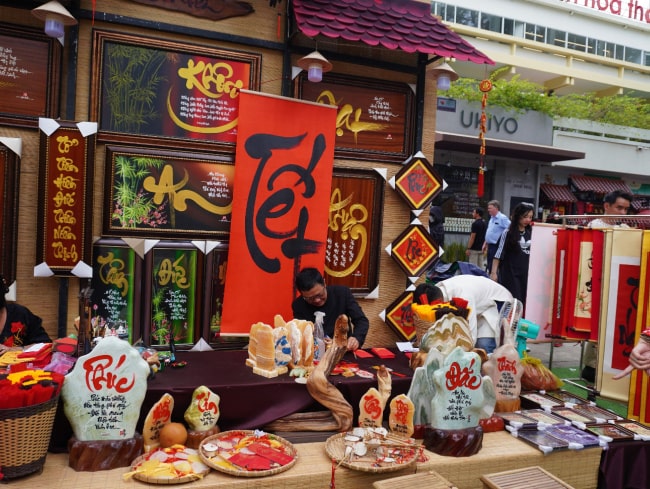
Like some other Asian countries such as China and Singapore, Lunar New Year is the vital mark of the end of the old lunar year and the beginning of the new lunar year. In Vietnam, Tet can be said to be the most traditional and important festival with a series of activities and traditional customs lasting from the end of the final month until the early days of the first month of the new year.
When is Tet?
There will be a leap month every 3 years in the Lunar Calendar while there is only a leap day (additional day in February - 29/2) every 4 years in the Gregorian calendar. That results in the difference in the time of Tet every year.
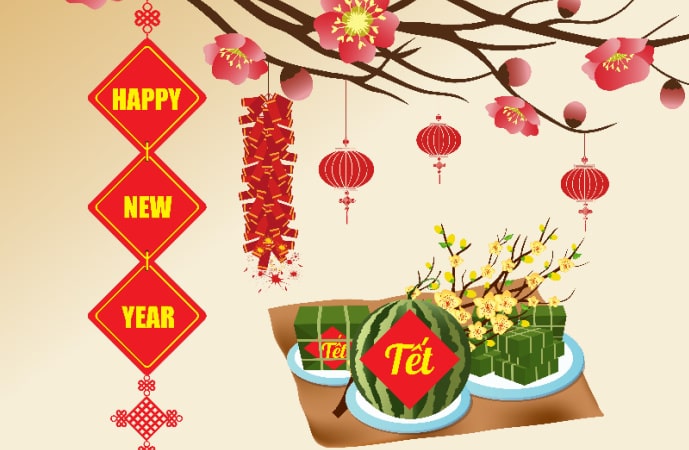
Tet falls in late January to early or mid-February according to the Gregorian calendar and is usually 1 or 2 months later than the New Year. For example, Tet 2023 falls on January 22 while Tet 2024 falls on February 10 and will last for 7-9 days.
| Zodiac Sign | Vietnamese Name | Years | New Year Date (Upcoming) |
|---|---|---|---|
| Cat | Mão | 2023, 2035, 2047, 2059, 2071 | January 22 (Sunday) |
| Dragon | Thìn | 2024, 2036, 2048, 2060, 2072 | February 10 (Wednesday) |
| Snake | Tỵ | 2025, 2037, 2049, 2061, 2073 | January 29 (Tuesday) |
| Horse | Ngọ | 2026, 2038, 2050, 2062, 2074 | February 17 (Saturday) |
| Goat | Mùi | 2027, 2039, 2051, 2063, 2075 | February 6 (Thursday) |
| Monkey | Thân | 2028, 2040, 2052, 2064, 2076 | January 26 (Wednesday) |
| Rooster | Dậu | 2029, 2041, 2053, 2065, 2077 | February 13 (Tuesday) |
| Dog | Tuất | 2030, 2042, 2054, 2066, 2078 | February 3 (Friday) |
| Pig | Hợi | 2031, 2043, 2055, 2067, 2079 | January 23 (Wednesday) |
| Rat | Tý | 2032, 2044, 2056, 2068, 2080 | February 11 (Monday) |
| Buffalo | Sửu | 2021, 2033, 2045, 2057, 2069 | January 31 (Sunday) |
| Tiger | Dần | 2022, 2034, 2046, 2058, 2070 | February 19 (Saturday) |
The origin of Tet
In fact, there is no definite document showing the real origin of Tet Nguyen Dan. Some opinions say that Lunar New Year originates from China while other studies show that it has existed since the beginning of the first century AD in Vietnam and in the legend story of "Banh Chung, Banh Day" from the time of the Hung kings before 1000-year Chinese domination of Vietnam.
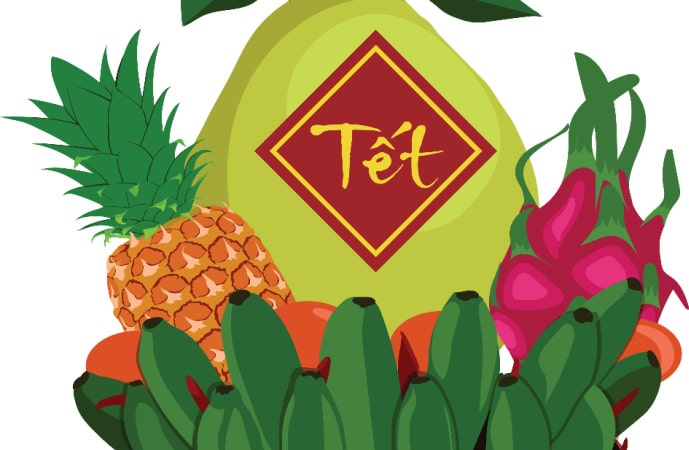
No matter when and where Tet comes from, Tet keeps its distinct traditions and customs from nation to nation but shares its beautiful meaning which is to welcome the new year, wish for luck and happiness, and show respect to parents and ancestors.
The meaning of Tet
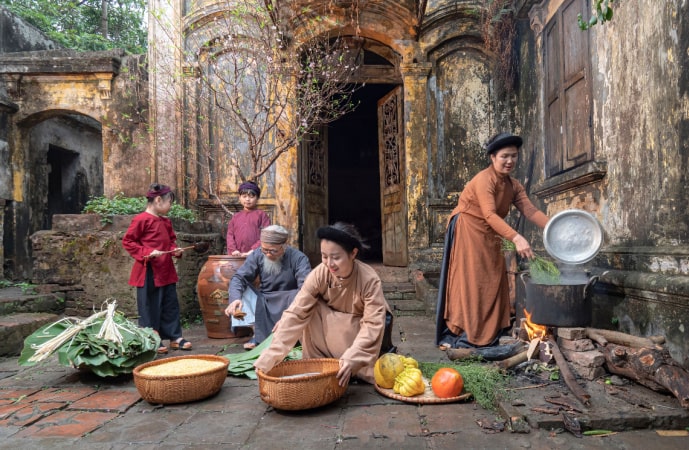
Transition moments between old and new year
Tet contains many meanings in religious culture, especially in the long-standing wet rice civilization culture of Vietnam. It is not only the transition moments between the old year and new year but also the intersection time between sky and earth, gods and humans. Tet is an occasion for everyone to express their gratitude to the gods, and wish for a new bountiful crop and a new year full of luck.
Family reunion day
Lunar New Year could be the most expected festival and holiday for all Vietnamese as all family members will have a chance to gather and reunite after a long time working or living far from their hometown. On these days, they will decorate houses together, meet relatives, have hearty meals with traditional Tet food, and spend as much time with each other as possible. That's how they express their love and respect to their parents as well as connect closely with families, relatives, and neighbors.
Respect to their ancestor
Tet has a bunch of spiritual activities such as preparing five-fruit trays and cooking the most solemn meals to present the ancestor's altar, worshiping Ong Cong - Ong Tao, or visiting ancestors' graves. This is an occasion for children and grandchildren to give thanks to grandparents and parents and show remembrance for their ancestors who have given birth to and nurtured them.
A rest and preparation for the new year
If Western nations have a long vacation from Christmas until New Year, Tet Nguyen Dan is the main new year holiday in Vietnam. Up to now, Tet is among the most awaited festivals to farmers during a crop as it is a long break between the harvest and the next crop.
Currently, Tet holiday usually lasts for 7 up to 9 days and is the longest holiday in a year. That's when everyone temporarily puts aside all work, looks back on the achievements and difficulties of the old year, takes a real break, and gets ready for a new year with new plans.
Traditional customs
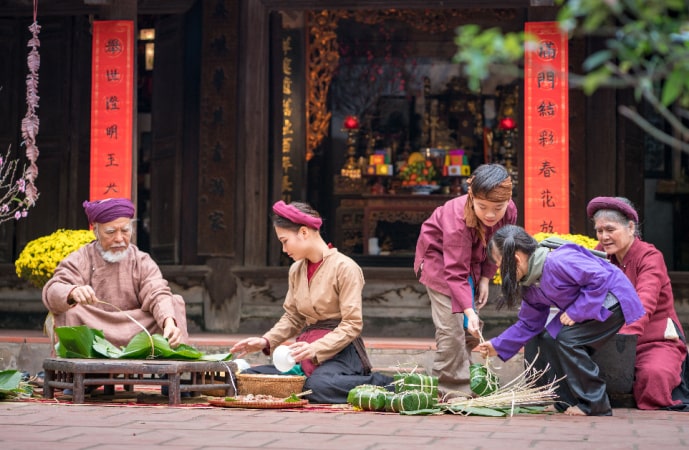
Before New Year’s Eve
Kitchen God Day (Ong Cong - Ong Tao)
This custom is related to a traditional belief of the Vietnamese people worshiping Ong Cong - Ong Tao on Lunar December 23rd every year. They are the kitchen gods who govern the affairs of the whole family. On this day, these gods are said to return to heaven to send the yearly report on family members to the Emperor.
On Kitchen God Day, every house cleans the altar, places new offerings including fruits, delicacies, fresh flowers, and paper caps and clothes, burns incense, and releases a carp. These offerings will be used by three gods on their journey back to heaven.
Wrapping Chung Cake - Tet Cake
Chung Cake in the North and Tet Cake in the South are unmissable traditional dishes in Tet. Before Tet comes, family members will gather and wrap these cakes to offer to the ancestral altar and prepare for the feast on the first days of the new year.
Cleaning and decorate house
For Vietnamese people, cleaning the house at the end of the year helps to remove the bad things of the old year, and decorating the home will welcome new luck and happiness in the new year.
Kumquat, peach blossom, or apricot blossom trees are the symbol of the Vietnamese New Year. Every house will buy at least one tree to place in the living room or in the yard in front of the house to announce that Tet is coming to their house. Moreover, many people choose fresh flower vases as another way to make their house solemn and refreshing.
Preparing five-fruit trays
Five-fruit tray on an ancestor's altar is a way to show respect to ancestors as well as pray for luck, happiness, health, and wealth in the new year. Depending on each region, each family will choose 5 different fruits and arrange them nicely on a tray, and put them on the altar during Tet.
Visiting ancestor’s grave
Each family often chooses a day before Tet and gathers all descendants at the graves of their ancestors to clean the graves, give offerings and burn incense. This is a vital custom to show gratitude and remembrance of descendants to the previous generations.
New Year’s Eve
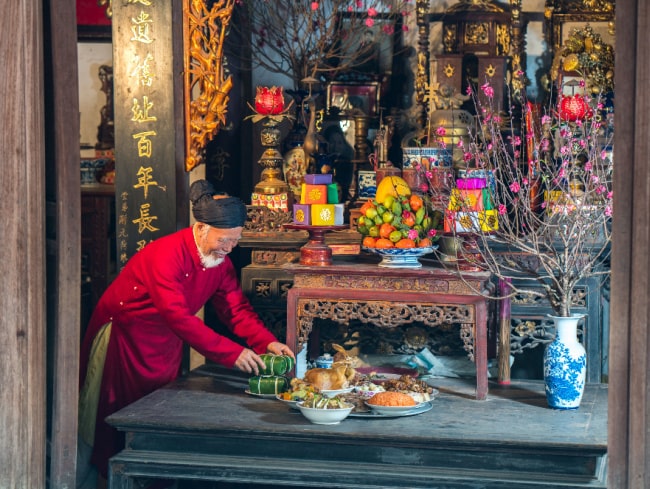
Ritual offerings to the ancestors
On New Year’s Eve (Lunar December 30th), ritual offerings to the ancestors and God cannot be missed. Each family prepares a tray of the most traditional food such as sticky rice, chicken, Chung cake, Vietnamese sausage, spring rolls, etc. This is to invite ancestors to enjoy Tet with the family and pray for a new year of peace and luck.
“Xông đất”
“Xông đất” is an indispensable tradition related to the first guest entering a house in the new year in Viet Nam. In regard to Vietnamese tradition, the “xông đất” person or the first person to enter the house will decide the fortune of the host family so he should be a person with good character, good health, morality, and success. Choosing the appropriate person helps to bring luck and blessings in the entire upcoming year.
New Year
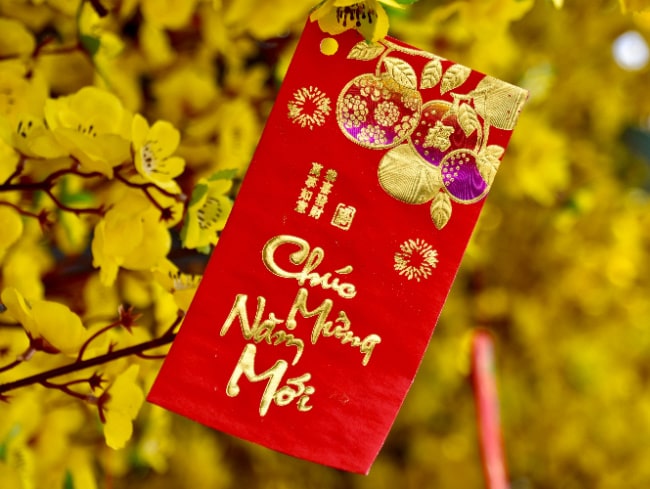
“Chúc Tết”
When Tet comes, the first and foremost thing to do is to come to grandparents’ houses and send them best wishes. We believe that the first words to say when meeting each other in the new year should be good wishes so that everyone will get good luck for the upcoming year. Usually, the younger will come to “chúc Tết” the elder first and all family members also enjoy the first meals together when they meet each other on the first day.
Vietnamese usually celebrate Tet on the first 3 days during which we spend the first day visiting the paternal side, the second day visiting the maternal side, and the third day visiting teachers.
Give lucky money
Lucky money, or “Lì xì”, is usually given to young children and the elderly with the wishes for children to grow up quickly, obediently, and study well, and the elderly to live a healthy long life. However, lucky money is also given by siblings or friends as a wish for a new year of good luck and peace.
Go to the pagoda
The beginning of the new year is also the time when people put aside all greed and envy in their hearts and aim for good things. Going to pagodas or temples is both to gain the purity of the soul and to pray for health, happiness, and peace in the new year. Moreover, this could also be a family outing during the long holiday, a chance to stay close and connect with each other.
Traditional food on Tet
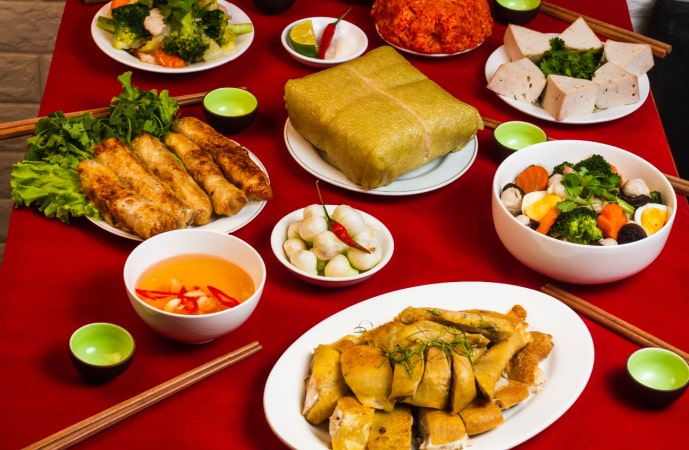
Chung cake and Tet cake (Sticky rice cake)
If Chung cake is the traditional food in Northern Vietnam, Tet cake is more popular in Central and Southern regions during the Vietnamese New Year. Both types of cake are made from similar ingredients such as sticky rice, green bean, pork, and ground black pepper. The difference is that Chung cake is wrapped in a square shape while Tet cake has a cylindrical shape.
Chung cake and tet cake are covered with “dong” leaves or banana leaves and boiled for 8 to 10 hours. They can be stored at room temperature for up to 1 week and are always one of the musts in every meal on Tet.
Boiled chicken
Not a special dish but chicken is indispensable food on Tet feasts. Chicken is considered one of the most quintessential and nutritious dishes to offer to ancestors. We choose healthy and meaty roosters, boil them and decorate them with a rose in their mouth and place them on our ancestor's altar. After the prayer session, boiled chickens will be cut into small pieces to enjoy.
“Gac” sticky rice
Chicken and sticky rice are the best food pair in every Vietnamese traditional food tray. On Tet, “Gac” sticky rice is always chosen thanks to its red color which is believed to bring good luck in the new year. “Gac”, also known as baby jackfruit, is popular in Vietnam to make food or natural red-orange colors for food as well as some medicines.
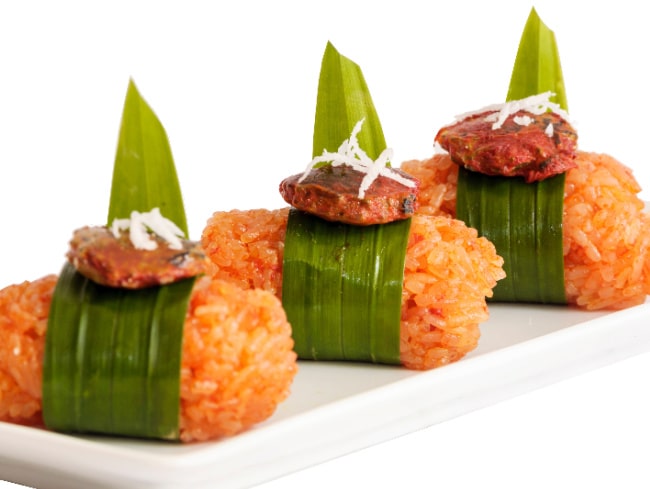
Gio lua (Vietnamese sausage)
Only from minced lean pork with some seasonings such as fish sauce, pepper, salt, and oil, Gio lua is a simple but delicious food on Tet. After wrapped in the fresh banana leaves in a cylindrical shape, Gio lua is boiled or steamed until well cooked. When serving, we cut them into 1-inch thick slices and 6 small pieces per slice. Gio lua with sticky rice or sticky rice cake is the favorite dish of many Vietnamese people, both on Tet and in daily meals.
Spring rolls
A dish that is both delicious, nutritionally balanced, and eye-catching call out spring roll. In the new year, crispy or deep-fried spring rolls are more popular than fresh ones. Crispy spring rolls are made from meat (pork, beef, or chicken), vermicelli, some vegetables and herbs such as carrots, onions, mushrooms, coriander, basil, and egg. The dish is enjoyed with sweet, sour and spicy dipping sauce and fresh lettuce.
Mut Tet (candied fruit) and nuts
Besides the colorful sweets, the tea table to welcome guests on Lunar New Year in Vietnam cannot lack candied fruits and nuts. They could be candied coconut, candied tamarind, candied ginger, candied carrot, etc. Nuts such as watermelon seeds, pumpkin seeds, sunflower seeds, pistachio,... are favorite snacks, good for health and create an intimate atmosphere in the new year.
Pickled onion
Vietnamese food focuses not only on taste but also on nutritional balance for health. While enjoying a variety of meat and protein dishes, pickled onions help balance the taste, reduce the greasy taste of meat, and promote digestion. Pickled onions have a sweet and sour taste, are crunchy, and can be stored for a month in the refrigerator. Therefore, you can find this dish in almost all families in Vietnam on Tet.
Travel tips
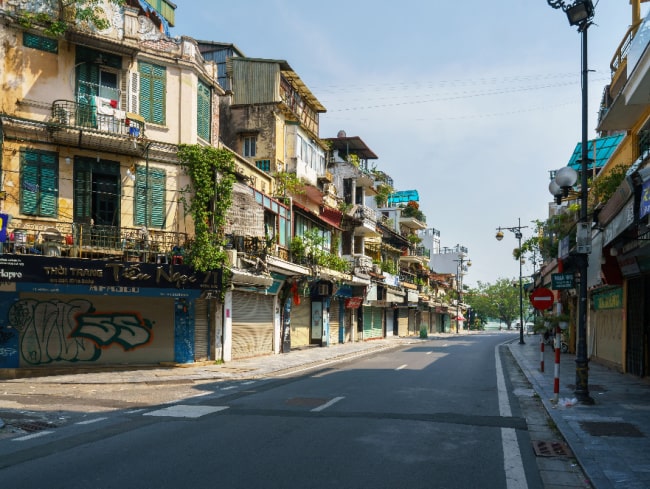
Whether on purpose or not, coming to Vietnam during the holidays will bring memorable experiences. Especially, when you come on big holidays like Tet, you probably should know some important information so as not to be surprised by customs or changes in the daily life of local people.
As mentioned above, Tet is when Vietnamese go back to their hometown, reunite with family and have a long vacation. Therefore, many things will be affected a bit such as transportation, shopping areas, restaurants, administrative offices, etc. Here are some travel tips to prepare for a smooth trip to Vietnam during Tet that you will need:
Check your visa and passport carefully
Government or administrative offices will be closed during Tet. In the event of an emergency, there will still be a staff on hand to assist you. However, the processing time may still take longer than usual and affect your trip. Therefore, make sure your passport is valid, your visa is well done, and keep them in a safe place during the trip.
Book the transportation early
If you are planning to travel by air/train/local coach, book them at least 2 - 4 weeks in advance. Due to the high demand for domestic passengers who come back to their hometowns, transportation tickets will run out very quickly. If not, you will have fewer choices for a preferable schedule. Although the price may not rise or slightly rises, early booking will avoid the situation of running out of tickets.
Holiday surcharge for accommodation
The room rate for accommodations such as hotels, resorts, and cruises will increase by 10 to 20% during Tet. This is due to increased food costs, service charges paid to employees who have to work overtime during the New Year holidays, or parties and festive activities held at the accommodation.
Plan your trip well
Many indoor attractions such as museums, exhibitions, art galleries, etc. will shut down during Tet, mainly for 4 days from Lunar December 30th to January 3rd. Hence, you can visit the city, enjoy the beach, and explore the natural landscapes without entrance fees on these days and visit indoor sites the other days. Some restaurants and shopping malls may close in a shorter time but it would be best to check the Tet closing time before going to avoid money and time wasting.
References
Questions and Answers (0)
Be the first to ask a question on this page!
Frequently asked questions
Contact sales if you have additional questions.
Contact support if you already submitted your visa application on our website.
Back to topWhy apply with us
- 99% on time delivery
- Easy & simple form
- 15+ years of experience
- No hidden charges
- 100% money back guarantee for declined applications
